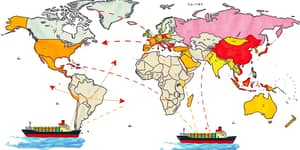
As the world grapples with uneven growth, China’s economy is forging ahead with remarkable speed. Its rebound not only reshapes domestic prospects but also defines the broader economic horizon for Asia. In a landscape marked by global uncertainty, the dragon’s roar is echoing across regional markets.
By outpacing major peers, China demonstrates how a blend of policy agility and targeted investment can revive growth. This article explores the forces driving this resurgence, the challenges it faces and the implications for Asia’s future.
In Q1 2025, China’s GDP expanded by 5.4% year-on-year, and 1.2% quarter-on-quarter. This performance contrasts sharply with subdued growth in advanced economies, where output often struggles to clear the 2% mark.
For 2025, authorities have set an official growth target of “around 5%”. Leading global banks forecast real GDP growth in the range of 4.7% to 5.0%, while some scenarios suggest outcomes as low as 3% without continued support.
Reaching or exceeding this goal would represent a “soft landing” for China—a transformation from crisis management toward a sustainable expansion that could anchor regional stability.
China’s rebound is underpinned by a multifaceted approach spanning external demand, private spending and government intervention.
These pillars work in concert. Export competitiveness strengthens domestic production lines, while government incentives ignite consumer confidence and spending. High-tech investment then cements long-term productivity gains.
Regionally, China’s export strength creates spill-overs. Suppliers in Southeast Asia benefit from expanded orders, even as China takes on more advanced manufacturing tasks.
Amid the upsides, significant headwinds threaten to stall the recovery’s momentum if left unaddressed.
The property sector, after years of boom and bust cycles, continues to weigh heavily on household balance sheets. Although prices show tentative stabilization, debt-to-GDP ratios in some municipalities approach critical levels.
If local governments lean too heavily on land sales and infrastructure investment, they risk crowding out private enterprise and stoking fresh vulnerabilities.
As the largest economy in Asia, China’s performance dictates regional trajectories. Its import demand supports commodity producers and manufacturing hubs from Malaysia to Vietnam.
China’s investments in clean energy and technology create knock-on benefits for partners. Solar module exports, electric vehicle component production and green finance initiatives are consolidating a regional shift toward sustainability.
Russian and Central Asian gas suppliers, Southeast Asian electronics manufacturers and even service providers in Australia see direct gains from China’s policy pivots.
Despite robust headline data, the recovery’s depth and durability remain in question.
The growth model still depends on government-led fiscal and monetary measures rather than purely market-driven expansion. Private investment and foreign direct investment have yet to fully rebound, highlighting ongoing wariness.
Looking ahead, policymakers face a crucial decision: maintain or taper stimulus. Premature tightening could derail nascent momentum, yet open-ended support risks exacerbating debt pressures.
Moreover, external environments remain volatile. New trade frictions or currency swings may expose China’s export model to fresh vulnerabilities.
China’s post-pandemic springboard has reignited regional growth and collaboration, yet the pathway forward is fraught with trade-offs.
Stakeholders across Asia can harness this momentum by adapting strategies to evolving conditions:
By embracing these steps, businesses, investors and policymakers can turn China’s recovery into a collective regional triumph rather than a solitary rebound.
Ultimately, China’s trajectory will either pave the way for an inclusive Asian resurgence or serve as a cautionary tale of over-reliance on stimulus. The choices made in Beijing and beyond in 2025 will determine which narrative prevails.
References













